Natural language names
 | Tür |
 | Door |
 | Porte |
Change log
| Item | SPF | XML | Change | Description | IFC2x3 to IFC4 4.0.0.0 |
|---|---|---|---|---|
| IfcDoor | ||||
| OwnerHistory | MODIFIED | Instantiation changed to OPTIONAL. | ||
| PredefinedType | ADDED | |||
| OperationType | ADDED | |||
| UserDefinedOperationType | ADDED | IFC4x2 Candidate 4.2.0.0 | ||
| IfcDoor | ||||
| PositionedRelativeTo | ADDED | IFC4x3_RC3 to IFC4x3_RC4 | ||
| IfcDoor | ||||
| HasSurfaceFeatures | ADDED |
Semantic definitions at the entity
Entity definition
The door is a built element that is predominately used to provide controlled access for people, goods, animals and vehicles. It includes constructions with hinged, pivoted, sliding, and additionally revolving and folding operations.
NOTE Definition according to ISO 6707-1: construction for closing an opening, intended primarily for access with hinged, pivoted or sliding operation.
The IfcDoor defines a particular occurrence of a door inserted in the spatial context of a project. A door can:
- be inserted as a filler in an opening using the IfcRelFillsElement relationship, then the IfcDoor has an inverse attribute FillsVoids provided;
NOTE View definitions or implementer agreements may restrict the relationship to only include one door into one opening.
- be part of an element assembly, in general an IfcCurtainWall, using the IfcRelAggregates relationship, then the IfcDoor has an inverse attribute Decomposes is provided;
- be a "free standing" door, then the IfcDoor has no inverse attributes FillsVoids or Decomposes provided.
This specification provides two main representations for door occurrences:
- IfcDoor used for all occurrences of doors, that have a 'Profile' shape representation defined to which a set of shape parameters for lining and framing properties apply. Additionally it requires the provision of an IfcDoorType that references one IfcDoorLiningProperties and on to many IfcDoorPanelProperties;
NOTE The entity IfcDoorStandardCase has been deprecated.
- IfcDoor used for all other occurrences of doors, particularly for doors having only 'Brep', or 'SurfaceModel' geometry without applying shape parameters.
The actual parameters of the door and/or its shape are defined by the IfcDoor as the occurrence definition (or project instance), or by the IfcDoorType as the specific definition (or project type). The following parameters are given:
- at the IfcDoor or IfcDoorStandardCase for occurrence specific parameters. The IfcDoor specifies:
- the door width and height
- the door opening direction (by the y-axis of the ObjectPlacement)
- at the IfcDoorType, to which the IfcDoor is related by the inverse relationship IsTypedBy pointing to IfcRelDefinesByType, for type parameters common to all occurrences of the same type.
- the operation type (single swing, double swing, revolving, etc.)
- the door hinge side (by using two different styles for right and left opening doors)
- the construction material type
- the particular attributes for the lining by the IfcDoorLiningProperties
- the particular attributes for the panels by the IfcDoorPanelProperties
HISTORY New entity in IFC1.0.
IFC4 CHANGE The attributes PredefinedType and OperationType are added, the applicable type object has been changed to IfcDoorType.
The geometric representation of IfcDoor is given by the IfcProductDefinitionShape, allowing multiple geometric representations. The IfcDoor may get its parameter and shape from the IfcDoorType. If an IfcRepresentationMap (a block definition) is defined for the IfcDoorType, then the IfcDoor inserts it through the IfcMappedItem.
The geometric representation of IfcDoor is defined using the following (potentially multiple) IfcShapeRepresentation's for its IfcProductDefinitionShape:
- Profile: A 'Curve3D' consisting of a single losed curve defining the outer boundary of the door (lining). The door parametric representation uses this profile in order to apply the door lining and panel parameter. If not provided, the profile of the IfcOpeningElement is taken.
- FootPrint: A 'GeometricCurveSet', or 'Annotation2D' representation defining the 2D shape of the door
- Body: A 'SweptSolid', 'SurfaceModel', or 'Brep' representation defining the 3D shape of the door.
In addition the parametric representation of a (limited) door shape is available by applying the parameters from IfcDoorType referencing IfcDoorLiningProperties and IfcDoorPanelProperties. The purpose of the parameter is described at those entities and below (door opening operation by door type).
The overall size of the IfcDoor to be used to apply the lining or panel parameter provided by the IfcDoorType is determined by the IfcShapeRepresentation with the RepresentationIdentifier = 'Profile'.
Attribute definitions
| # | Attribute | Type | Cardinality | Description | G |
|---|---|---|---|---|---|
| 9 | OverallHeight | IfcPositiveLengthMeasure | ? | Overall measure of the height, it reflects the Z Dimension of a bounding box, enclosing the body of the door opening. If omitted, the OverallHeight should be taken from the geometric representation of the IfcOpening in which the door is inserted. NOTE The body of the door might be taller then the door opening (e.g. in cases where the door lining includes a casing). In these cases the OverallHeight shall still be given as the door opening height, and not as the total height of the door lining. | X |
| 10 | OverallWidth | IfcPositiveLengthMeasure | ? | Overall measure of the width, it reflects the X Dimension of a bounding box, enclosing the body of theE door opening. If omitted, the OverallWidth should be taken from the geometric representation of the IfcOpening in which the door is inserted. NOTE The body of the door might be wider then the door opening (e.g. in cases where the door lining includes a casing). In these cases the OverallWidth shall still be given as the door opening width, and not as the total width of the door lining. | X |
| 11 | PredefinedType | IfcDoorTypeEnum | ? | X | |
| 12 | OperationType | IfcDoorTypeOperationEnum | ? | Type defining the general layout and operation of the door type in terms of the partitioning of panels and panel operations. NOTE The OperationType shall only be used, if no type object IfcDoorType is assigned, providing its own IfcDoorType.OperationType. | X |
| 13 | UserDefinedOperationType | IfcLabel | ? | Designator for the user defined operation type, shall only be provided, if the value of OperationType is set to USERDEFINED. | X |
Formal Propositions
| Rule | Description |
|---|---|
| CorrectPredefinedType | Either the PredefinedType attribute is unset (e.g. because an IfcDoorType is associated), or the inherited attribute ObjectType shall be provided, if the PredefinedType is set to USERDEFINED. |
| CorrectTypeAssigned | Either there is no door type object associated, i.e. the IsTypedBy inverse relationship is not provided, or the associated type object has to be of type IfcDoorType. |
Inherited definitions from supertypes
Entity inheritance
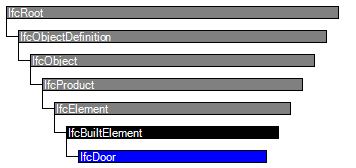
Attribute inheritance
| # | Attribute | Type | Cardinality | Description | G |
|---|---|---|---|---|---|
| IfcRoot | |||||
| 1 | GlobalId | IfcGloballyUniqueId | Assignment of a globally unique identifier within the entire software world. | X | |
| 2 | OwnerHistory | IfcOwnerHistory | ? |
Assignment of the information about the current ownership of that object, including owning actor, application, local identification and information captured about the recent changes of the object,
NOTE only the last modification in stored - either as addition, deletion or modification. IFC4 CHANGE The attribute has been changed to be OPTIONAL. | X |
| 3 | Name | IfcLabel | ? | Optional name for use by the participating software systems or users. For some subtypes of IfcRoot the insertion of the Name attribute may be required. This would be enforced by a where rule. | X |
| 4 | Description | IfcText | ? | Optional description, provided for exchanging informative comments. | X |
| IfcObjectDefinition | |||||
| HasAssignments | IfcRelAssigns @RelatedObjects | S[0:?] | Reference to the relationship objects, that assign (by an association relationship) other subtypes of IfcObject to this object instance. Examples are the association to products, processes, controls, resources or groups. | X | |
| Nests | IfcRelNests @RelatedObjects | S[0:1] | References to the decomposition relationship being a nesting. It determines that this object definition is a part within an ordered whole/part decomposition relationship. An object occurrence or type can only be part of a single decomposition (to allow hierarchical strutures only).
IFC4 CHANGE The inverse attribute datatype has been added and separated from Decomposes defined at IfcObjectDefinition. | X | |
| IsNestedBy | IfcRelNests @RelatingObject | S[0:?] | References to the decomposition relationship being a nesting. It determines that this object definition is the whole within an ordered whole/part decomposition relationship. An object or object type can be nested by several other objects (occurrences or types).
IFC4 CHANGE The inverse attribute datatype has been added and separated from IsDecomposedBy defined at IfcObjectDefinition. | X | |
| HasContext | IfcRelDeclares @RelatedDefinitions | S[0:1] | References to the context providing context information such as project unit or representation context. It should only be asserted for the uppermost non-spatial object.
IFC4 CHANGE The inverse attribute datatype has been added. | X | |
| IsDecomposedBy | IfcRelAggregates @RelatingObject | S[0:?] | References to the decomposition relationship being an aggregation. It determines that this object definition is whole within an unordered whole/part decomposition relationship. An object definitions can be aggregated by several other objects (occurrences or parts).
IFC4 CHANGE The inverse attribute datatype has been changed from the supertype IfcRelDecomposes to subtype IfcRelAggregates. | X | |
| Decomposes | IfcRelAggregates @RelatedObjects | S[0:1] | References to the decomposition relationship being an aggregation. It determines that this object definition is a part within an unordered whole/part decomposition relationship. An object definitions can only be part of a single decomposition (to allow hierarchical strutures only).
IFC4 CHANGE The inverse attribute datatype has been changed from the supertype IfcRelDecomposes to subtype IfcRelAggregates. | X | |
| HasAssociations | IfcRelAssociates @RelatedObjects | S[0:?] | Reference to the relationship objects, that associates external references or other resource definitions to the object.. Examples are the association to library, documentation or classification. | X | |
| IfcObject | |||||
| 5 | ObjectType | IfcLabel | ? | The type denotes a particular type that indicates the object further. The use has to be established at the level of instantiable subtypes. In particular it holds the user defined type, if the enumeration of the attribute PredefinedType is set to USERDEFINED. | X |
| IsDeclaredBy | IfcRelDefinesByObject @RelatedObjects | S[0:1] | Link to the relationship object pointing to the declaring object that provides the object definitions for this object occurrence. The declaring object has to be part of an object type decomposition. The associated IfcObject, or its subtypes, contains the specific information (as part of a type, or style, definition), that is common to all reflected instances of the declaring IfcObject, or its subtypes.
IFC4 CHANGE New inverse relationship, change made with upward compatibility for file based exchange. | X | |
| Declares | IfcRelDefinesByObject @RelatingObject | S[0:?] | Link to the relationship object pointing to the reflected object(s) that receives the object definitions. The reflected object has to be part of an object occurrence decomposition. The associated IfcObject, or its subtypes, provides the specific information (as part of a type, or style, definition), that is common to all reflected instances of the declaring IfcObject, or its subtypes.
IFC4 CHANGE New inverse relationship, change made with upward compatibility for file based exchange. | X | |
| IsTypedBy | IfcRelDefinesByType @RelatedObjects | S[0:1] | Set of relationships to the object type that provides the type definitions for this object occurrence. The then associated IfcTypeObject, or its subtypes, contains the specific information (or type, or style), that is common to all instances of IfcObject, or its subtypes, referring to the same type.
IFC4 CHANGE New inverse relationship, the link to IfcRelDefinesByType had previously be included in the inverse relationship IfcRelDefines. Change made with upward compatibility for file based exchange. | X | |
| IsDefinedBy | IfcRelDefinesByProperties @RelatedObjects | S[0:?] | Set of relationships to property set definitions attached to this object. Those statically or dynamically defined properties contain alphanumeric information content that further defines the object.
IFC4 CHANGE The data type has been changed from IfcRelDefines to IfcRelDefinesByProperties with upward compatibility for file based exchange. | X | |
| IfcProduct | |||||
| 6 | ObjectPlacement | IfcObjectPlacement | ? | Placement of the product in space, the placement can either be absolute (relative to the world coordinate system), relative (relative to the object placement of another product), or constraint (e.g. relative to grid axes). It is determined by the various subtypes of IfcObjectPlacement, which includes the axis placement information to determine the transformation for the object coordinate system. | X |
| 7 | Representation | IfcProductRepresentation | ? | Reference to the representations of the product, being either a representation (IfcProductRepresentation) or as a special case a shape representations (IfcProductDefinitionShape). The product definition shape provides for multiple geometric representations of the shape property of the object within the same object coordinate system, defined by the object placement. | X |
| ReferencedBy | IfcRelAssignsToProduct @RelatingProduct | S[0:?] | Reference to the IfcRelAssignsToProduct relationship, by which other products, processes, controls, resources or actors (as subtypes of IfcObjectDefinition) can be related to this product. | X | |
| PositionedRelativeTo | IfcRelPositions @RelatedProducts | S[0:?] | X | ||
| ReferencedInStructures | IfcRelReferencedInSpatialStructure @RelatedElements | S[0:?] | X | ||
| IfcElement | |||||
| 8 | Tag | IfcIdentifier | ? | The tag (or label) identifier at the particular instance of a product, e.g. the serial number, or the position number. It is the identifier at the occurrence level. | X |
| FillsVoids | IfcRelFillsElement @RelatedBuildingElement | S[0:1] | Reference to the IfcRelFillsElement Relationship that puts the element as a filling into the opening created within another element. | X | |
| ConnectedTo | IfcRelConnectsElements @RelatingElement | S[0:?] | Reference to the element connection relationship. The relationship then refers to the other element to which this element is connected to. | X | |
| IsInterferedByElements | IfcRelInterferesElements @RelatedElement | S[0:?] | Reference to the interference relationship to indicate the element that is interfered. The relationship, if provided, indicates that this element has an interference with one or many other elements.
NOTE There is no indication of precedence between IsInterferedByElements and InterferesElements. IFC4 CHANGE New inverse relationship. | X | |
| InterferesElements | IfcRelInterferesElements @RelatingElement | S[0:?] | Reference to the interference relationship to indicate the element that interferes. The relationship, if provided, indicates that this element has an interference with one or many other elements.
NOTE There is no indication of precedence between IsInterferedByElements and InterferesElements. IFC4 CHANGE New inverse relationship. | X | |
| HasProjections | IfcRelProjectsElement @RelatingElement | S[0:?] | Projection relationship that adds a feature (using a Boolean union) to the IfcBuildingElement. | X | |
| HasOpenings | IfcRelVoidsElement @RelatingBuildingElement | S[0:?] | Reference to the IfcRelVoidsElement relationship that creates an opening in an element. An element can incorporate zero-to-many openings. For each opening, that voids the element, a new relationship IfcRelVoidsElement is generated. | X | |
| IsConnectionRealization | IfcRelConnectsWithRealizingElements @RealizingElements | S[0:?] | Reference to the connection relationship with realizing element. The relationship, if provided, assigns this element as the realizing element to the connection, which provides the physical manifestation of the connection relationship. | X | |
| ProvidesBoundaries | IfcRelSpaceBoundary @RelatedBuildingElement | S[0:?] | Reference to space boundaries by virtue of the objectified relationship IfcRelSpaceBoundary. It defines the concept of an element bounding spaces. | X | |
| ConnectedFrom | IfcRelConnectsElements @RelatedElement | S[0:?] | Reference to the element connection relationship. The relationship then refers to the other element that is connected to this element. | X | |
| ContainedInStructure | IfcRelContainedInSpatialStructure @RelatedElements | S[0:1] | Containment relationship to the spatial structure element, to which the element is primarily associated. This containment relationship has to be hierachical, i.e. an element may only be assigned directly to zero or one spatial structure. | X | |
| HasCoverings | IfcRelCoversBldgElements @RelatingBuildingElement | S[0:?] | Reference to IfcCovering by virtue of the objectified relationship IfcRelCoversBldgElement. It defines the concept of an element having coverings associated. | X | |
| HasSurfaceFeatures | IfcRelAdheresToElement @RelatingElement | S[0:?] | Reference to the IfcRelAdheresToElement relationship that adheres a IfcSurfaceFeature to an element. An element can incorporate zero-to-many surface features in one relationship. | X | |
| IfcBuiltElement | |||||
| IfcDoor | |||||
| 9 | OverallHeight | IfcPositiveLengthMeasure | ? | Overall measure of the height, it reflects the Z Dimension of a bounding box, enclosing the body of the door opening. If omitted, the OverallHeight should be taken from the geometric representation of the IfcOpening in which the door is inserted. NOTE The body of the door might be taller then the door opening (e.g. in cases where the door lining includes a casing). In these cases the OverallHeight shall still be given as the door opening height, and not as the total height of the door lining. | X |
| 10 | OverallWidth | IfcPositiveLengthMeasure | ? | Overall measure of the width, it reflects the X Dimension of a bounding box, enclosing the body of theE door opening. If omitted, the OverallWidth should be taken from the geometric representation of the IfcOpening in which the door is inserted. NOTE The body of the door might be wider then the door opening (e.g. in cases where the door lining includes a casing). In these cases the OverallWidth shall still be given as the door opening width, and not as the total width of the door lining. | X |
| 11 | PredefinedType | IfcDoorTypeEnum | ? | X | |
| 12 | OperationType | IfcDoorTypeOperationEnum | ? | Type defining the general layout and operation of the door type in terms of the partitioning of panels and panel operations. NOTE The OperationType shall only be used, if no type object IfcDoorType is assigned, providing its own IfcDoorType.OperationType. | X |
| 13 | UserDefinedOperationType | IfcLabel | ? | Designator for the user defined operation type, shall only be provided, if the value of OperationType is set to USERDEFINED. | X |
Definitions applying to General Usage
IfcDoor
Concept usage
Door Attributes
The Door Attributes concept applies to this entity.
The opening direction is determined by the local placement of IfcDoor and the OperationType of the IfcDoorType as shown in Figure 368.
NOTE There are different definitions in various countries on what a left opening or left hung or left swing door is (same for right). Therefore the IFC definition may derivate from the local standard and need to be mapped appropriately.
| ||||||||||||||||||
Figure 368 — Door swing | ||||||||||||||||||
NOTE The OverallWidth and OverallHeight parameters are for informational purpose only.
Object Typing
The Object Typing concept template applies to this entity as shown in Table 186.
| |||||||||
Table 186 — IfcDoor Object Typing |
Property Sets for Objects
The Property Sets for Objects concept template applies to this entity as shown in Table 187.
Quantity Sets
The Quantity Sets concept template applies to this entity as shown in Table 188.
| ||||
Table 188 — IfcDoor Quantity Sets |
Material Constituent Set
The Material Constituent Set concept template applies to this entity as shown in Table 189.
| ||
Table 189 — IfcDoor Material Constituent Set |
The material of the IfcDoor is defined by the IfcMaterialConstituentSet or as fall back by IfcMaterial and attached by the IfcRelAssociatesMaterial relationship.
Product Local Placement
The Product Local Placement concept template applies to this entity as shown in Table 190.
Table 190 — IfcDoor Product Local Placement |
The following restriction is imposed:
- The PlacementRelTo relationship of IfcLocalPlacement shall point to the local placement of the same element (if given), in which the IfcDoor is used as a filling (normally an IfcOpeningElement), as provided by the IfcRelFillsElement relationship;
- If the IfcDoor is part of an assembly, e.g. an IfcCurtainWall, then the PlacementRelTo relationship of IfcLocalPlacement shall point (if given) to the local placement of that assembly;
- If the IfcDoor is not inserted into an IfcOpeningElement, then the PlacementRelTo relationship of IfcLocalPlacement shall point (if given) to the local placement of the same IfcSpatialStructureElement that is used in the ContainedInStructure inverse attribute or to a referenced spatial structure element at a higher level.
NOTE The product placement is used to determine the opening direction of the door.
Profile 3D Geometry
The Profile 3D Geometry concept applies to this entity.
The door profile is represented by a three-dimensional closed curve within a particular shape representation. The profile is used to apply the parameter of the parametric door representation. Only a single closed curve shall be contained in the set of IfcShapeRepresentation.Items.
A 'Profile' representation has to be provided if a parametric representation is applied to the door.
Spatial Containment
The Spatial Containment concept template applies to this entity as shown in Table 191.
| ||||||||||
Table 191 — IfcDoor Spatial Containment |
The IfcDoor, as any subtype of IfcBuildingElement, may participate alternatively in one of the two different containment relationships:
- the Spatial Containment (defined here), or
- the Element Composition.
The IfcDoor may also be connected to the IfcOpeningElement in which it is placed as a filler. In this case, the spatial containment relationship shall be provided, see Figure 369.
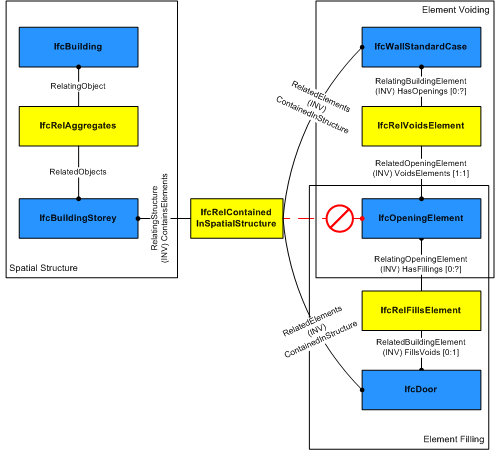 |
NOTE The containment shall be defined independently of the filling relationship, that is, even if |
|
Figure 369 — Door spatial containment |
mvdXML Specification
<?xml version="1.0" encoding="utf-8"?>
<ConceptRoot xmlns:xsi="http://www.w3.org/2001/XMLSchema-instance" uuid="cfa0c4e5-b786-478c-9d60-1455913bdfac" name="IfcDoor" applicableRootEntity="IfcDoor">
<Applicability>
<Template ref="d2278787-a9a5-4b89-b6cb-d0cf9613610a" />
<TemplateRules operator="and">
</TemplateRules>
</Applicability>
<Concepts>
<Concept uuid="c172cb11-5adc-46ff-b037-57ae10dc1bc0" name="Door Attributes">
<Template ref="1e5da429-cf7c-4f23-8b32-53ad98e238ad" />
</Concept>
<Concept uuid="5c1fbcff-488b-45cf-ae71-350eb5fef64d" name="Object Typing">
<Template ref="35a2e10e-20df-40f4-ab2f-dacf0a6744f4" />
<TemplateRules operator="and">
<TemplateRule Parameters="RelatingType[Type]='IfcDoorType'" />
<TemplateRule Description="> NOTE&nbsp;This type is deprecated" Parameters="RelatingType[Type]='IfcDoorStyle'" />
</TemplateRules>
</Concept>
<Concept uuid="0100dbf6-8637-4961-bb6a-ae856ccbba2d" name="Property Sets for Objects">
<Template ref="f74255a6-0c0e-4f31-84ad-24981db62461" />
<TemplateRules operator="and">
<TemplateRule Parameters="PsetName[Value]='Pset_DoorCommon'" />
<TemplateRule Parameters="PsetName[Value]='Pset_DoorWindowGlazingType'" />
</TemplateRules>
</Concept>
<Concept uuid="41fd9f98-bfc2-4d16-a509-82c85c2240f7" name="Quantity Sets">
<Template ref="6652398e-6579-4460-8cb4-26295acfacc7" />
<TemplateRules operator="and">
<TemplateRule Parameters="QsetName[Value]='Qto_DoorBaseQuantities'" />
</TemplateRules>
</Concept>
<Concept uuid="75a2e6d9-24bc-47a8-b944-934666ba6aa2" name="Material Constituent Set">
<Template ref="d96f7f7d-e742-4db8-9b5d-18a36a6df884" />
<TemplateRules operator="and">
<TemplateRule Description="Indicates that the material constituent applies to the door lining." />
<TemplateRule Description="Indicates that the material constituent applies to the door panel(s); if not provided, the 'Lining' material information applies to panel(s) as well." />
<TemplateRule Description="Indicates that the material constituent applies to the glazing part." />
</TemplateRules>
</Concept>
<Concept uuid="5c0a2329-04ad-489f-b1ff-0ec1f6eccae2" name="Product Local Placement">
<Template ref="cbe85b5f-7912-4a43-8bb7-1e63bf40b26d" />
</Concept>
<Concept uuid="5abb68db-3de6-4ef4-b0d7-4d78bb986a8c" name="Profile 3D Geometry">
<Template ref="1d897220-740d-4793-9a8d-5d2774c7bc00" />
</Concept>
<Concept uuid="f3a3befd-278f-4a46-96f2-7d3344e5acb3" name="Spatial Containment">
<Template ref="d9a3f822-0014-4bc2-8d94-9d9067759045" />
<TemplateRules operator="and">
<TemplateRule Description="Default spatial container" Parameters="RelatingStructure[Type]='IfcBuildingStorey'" />
<TemplateRule Description="Spatial container for the element if it cannot be assigned to a building storey" Parameters="RelatingStructure[Type]='IfcBuilding'" />
<TemplateRule Description="Spatial container for the element in case that it is placed on site (outside of building)" Parameters="RelatingStructure[Type]='IfcSite'" />
<TemplateRule Description="In particular use cases, a door maybe assigned directly to space" Parameters="RelatingStructure[Type]='IfcSpace'" />
</TemplateRules>
</Concept>
</Concepts>
</ConceptRoot>
Concept inheritance
| # | Concept | Template | Model View |
|---|---|---|---|
| IfcRoot | |||
| Identity | Software Identity | General Usage | |
| Revision Control | Revision Control | General Usage | |
| IfcObjectDefinition | |||
| Classification Association | Classification Association | General Usage | |
| Assignment to Product | Assignment to Product | General Usage | |
| IfcObject | |||
| Object User Identity | Object User Identity | General Usage | |
| Object Predefined Type | Object Predefined Type | General Usage | |
| Property Sets with Override | Property Sets with Override | General Usage | |
| IfcProduct | |||
| Product Placement | Product Placement | General Usage | |
| Product Geometric Representation | Product Geometric Representation | General Usage | |
| Relative Position | Product Relative Positioning | General Usage | |
| Product Span Positioning | Product Span Positioning | General Usage | |
| Product Geometry Colour | Product Geometry Colour | General Usage | |
| Product Geometry Layer | Product Geometry Layer | General Usage | |
| Product Relative Placement | Product Relative Placement | General Usage | |
| IfcElement | |||
| Element Interference | Element Interference | General Usage | |
| CoG Geometry | CoG Geometry | General Usage | |
| Box Geometry | Box Geometry | General Usage | |
| FootPrint Geometry | FootPrint Geometry | General Usage | |
| Body SurfaceOrSolidModel Geometry | Body SurfaceOrSolidModel Geometry | General Usage | |
| Body SurfaceModel Geometry | Body SurfaceModel Geometry | General Usage | |
| Body Tessellation Geometry | Body Tessellation Geometry | General Usage | |
| Body Brep Geometry | Body Brep Geometry | General Usage | |
| Body AdvancedBrep Geometry | Body AdvancedBrep Geometry | General Usage | |
| Body CSG Geometry | Body CSG Geometry | General Usage | |
| Mapped Geometry | Mapped Geometry | General Usage | |
| Element Openings | Element Openings | General Usage | |
| Element Projecting | Element Projecting | General Usage | |
| Linear Placement | Product Linear Placement | General Usage | |
| Element Voiding Features | Element Voiding Features | General Usage | |
| Surface Feature Adherence | Surface Feature Adherence | General Usage | |
| Body AdvancedSwept Directrix Geometry | Body AdvancedSwept Directrix Geometry | General Usage | |
| Body AdvancedSwept DiskSolid PolyCurve Geometry | Body AdvancedSwept DiskSolid PolyCurve Geometry | General Usage | |
| Body AdvancedSwept Tapered Geometry | Body AdvancedSwept Tapered Geometry | General Usage | |
| Body SectionedSolidHorizontal | Body SectionedSolidHorizontal | General Usage | |
| Body SweptSolid Composite Geometry | Body SweptSolid Composite Geometry | General Usage | |
| Body SweptSolid ParameterizedProfile Geometry | Body SweptSolid ParameterizedProfile Geometry | General Usage | |
| Body SweptSolid CompositeCurve Geometry | Body SweptSolid CompositeCurve Geometry | General Usage | |
| Body SweptSolid PolyCurve Geometry | Body SweptSolid PolyCurve Geometry | General Usage | |
| FootPrint Annotation Geometry | FootPrint Annotation Geometry | General Usage | |
| FootPrint GeomSet PolyCurve Geometry | FootPrint GeomSet PolyCurve Geometry | General Usage | |
| Surface Sectioned Geometry | Surface Sectioned Geometry | General Usage | |
| Surface Tessellation Geometry | Surface Tessellation Geometry | General Usage | |
| Product Grid Placement | Product Grid Placement | General Usage | |
| IfcBuiltElement | |||
| Product Assignment | Product Assignment | General Usage | |
| Surface 3D Geometry | Surface 3D Geometry | General Usage | |
| Material Set | Material Set | General Usage | |
| IfcDoor | |||
| Door Attributes | Door Attributes | General Usage | |
| Object Typing | Object Typing | General Usage | |
| Property Sets for Objects | Property Sets for Objects | General Usage | |
| Quantity Sets | Quantity Sets | General Usage | |
| Material Constituent Set | Material Constituent Set | General Usage | |
| Product Local Placement | Product Local Placement | General Usage | |
| Profile 3D Geometry | Profile 3D Geometry | General Usage | |
| Spatial Containment | Spatial Containment | General Usage | |
Formal representations
XML Specification
<xs:element name="IfcDoor" type="ifc:IfcDoor" substitutionGroup="ifc:IfcBuiltElement" nillable="true"/>
<xs:complexType name="IfcDoor">
<xs:complexContent>
<xs:extension base="ifc:IfcBuiltElement">
<xs:attribute name="OverallHeight" type="ifc:IfcPositiveLengthMeasure" use="optional"/>
<xs:attribute name="OverallWidth" type="ifc:IfcPositiveLengthMeasure" use="optional"/>
<xs:attribute name="PredefinedType" type="ifc:IfcDoorTypeEnum" use="optional"/>
<xs:attribute name="OperationType" type="ifc:IfcDoorTypeOperationEnum" use="optional"/>
<xs:attribute name="UserDefinedOperationType" type="ifc:IfcLabel" use="optional"/>
</xs:extension>
</xs:complexContent>
</xs:complexType>
EXPRESS Specification
ENTITY IfcDoor
SUPERTYPE
SUBTYPE OF (IfcBuiltElement);
OverallHeight : OPTIONAL IfcPositiveLengthMeasure;
OverallWidth : OPTIONAL IfcPositiveLengthMeasure;
PredefinedType : OPTIONAL IfcDoorTypeEnum;
OperationType : OPTIONAL IfcDoorTypeOperationEnum;
UserDefinedOperationType : OPTIONAL IfcLabel;
WHERE
CorrectPredefinedType : NOT(EXISTS(PredefinedType)) OR
(PredefinedType <> IfcDoorTypeEnum.USERDEFINED) OR
((PredefinedType = IfcDoorTypeEnum.USERDEFINED) AND EXISTS (SELF\IfcObject.ObjectType));
CorrectTypeAssigned : (SIZEOF(IsTypedBy) = 0) OR
('IFCSHAREDBLDGELEMENTS.IfcDoorType' IN TYPEOF(SELF\IfcObject.IsTypedBy[1].RelatingType));
END_ENTITY;

 Instance diagram
Instance diagram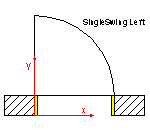
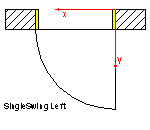

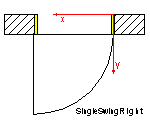
 Link to this page
Link to this page